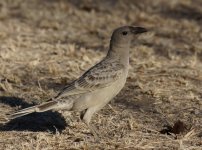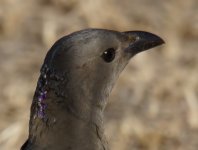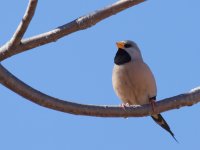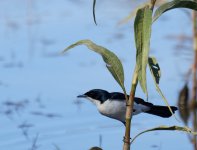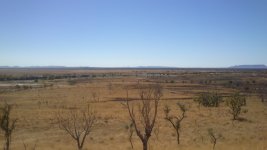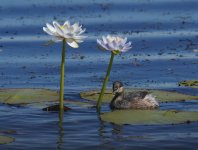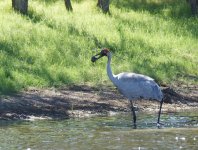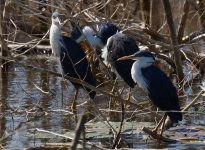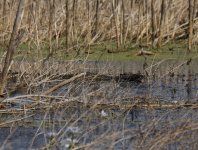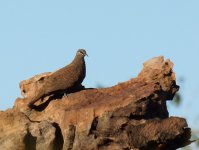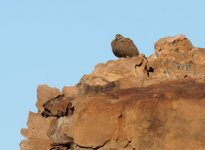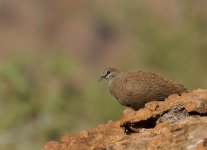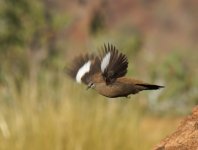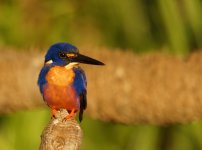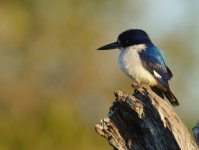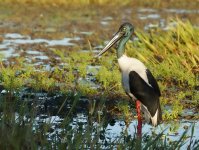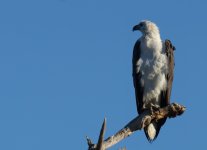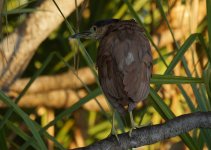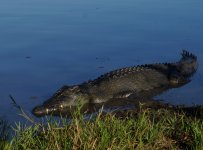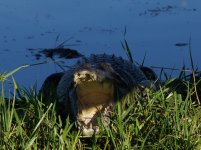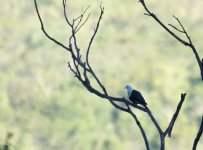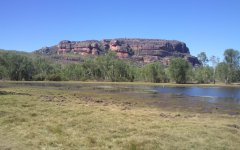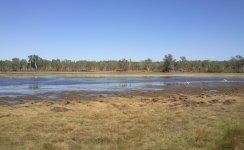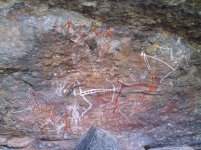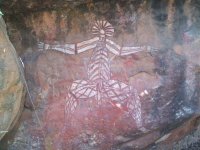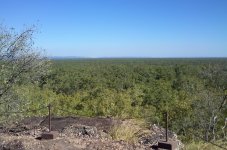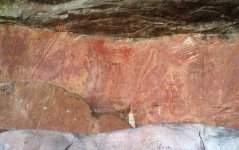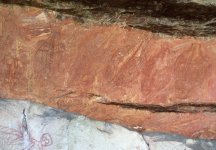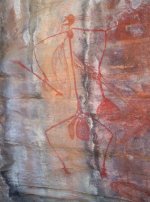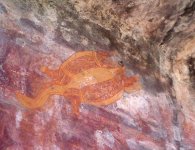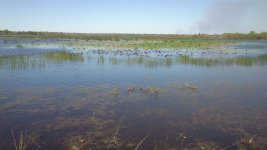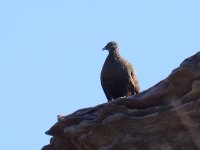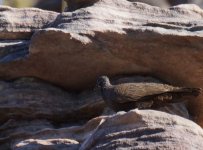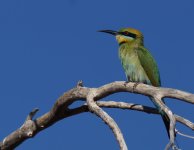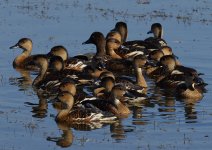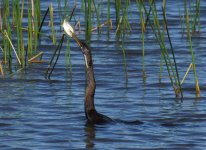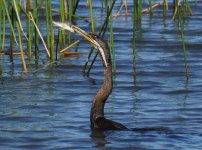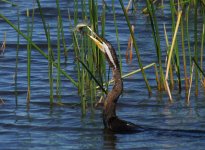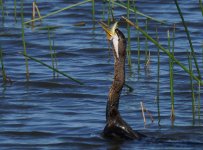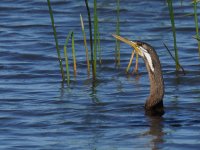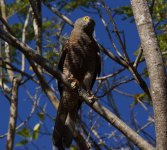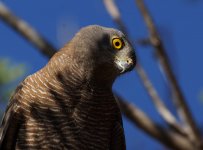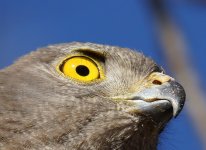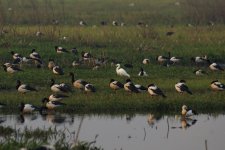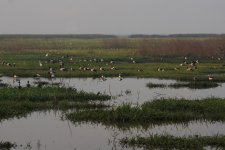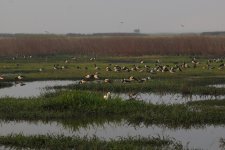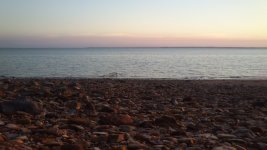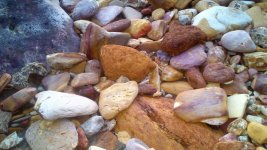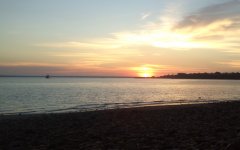
Day Forty-three: Parry Creek – Marglu Billabong – Wyndham – Kununurra – Keep River
I was up at dawn for a look around Parry Creek Farm. Things began well with some good but brief views of a Buff-sided Robin behind the toilet block. Later in the morning I had some better views of a pair a bit further up the creek at another waterhole. Definitely a ‘better than it looks in the book bird’ – really smart in fact, and fairly chunky and characterful.
I settled down at the end of the waterhole for a bit to watch what came in. There was a steady succession of small numbers of Masked and Long-tailed Finches, but only two Gouldian Finches – both red-faced – came in to drink. A Black-necked Stork sailed over and an Azure Kingfisher gave close views. Very large numbers of Diamond, Peaceful and Bar-shouldered Doves also swirled in for a drink. A walk further up the creek produced a good mix of birds including a few Lemon-bellied Flycatchers, another juvenile Gouldian Finch and a flock of Star Finches.
Then I headed back to Marglu Lagoon, where plenty was happening. I had thought about having a wander round the whole lake system, but was put off by the sight of two quite substantial Saltwater Crocodiles close to the viewing platform. Three Wandering Whistling Duck were new for the trip, as were a Whiskered Tern and a Pheasant Coucal. Raptors were particularly prominent and - in addition to the usual industrial quantities of Black and Whistling Kites - Brown Goshawk, White-bellied Sea-eagle and Swamp Harrier all appeared. Lots of waterbirds included both species of spoonbill, several Brolgas and good numbers of Pied Herons. An Australian Pratincole sailed over and lots of Fairy Martins were around too. As I drove out towards Wyndham I had conclusive but not great views of a Black-breasted Buzzard flying off towards the hills.
Wyndham Port was a bit lacking in birds, although it was nice to see the sea again, albeit a very different looking one to the last I’d seen in South Australia. In the rather beleaguered strip of mangroves I had good views of a Yellow White-eye and also saw the first Striated Heron of the trip. I then had quick stops at the Grotto and at Lake Kununurra but didn’t see anything new.
I drove back across into the Northern Territory late in the afternoon and headed back to Keep River National Park where I camped. I had a wander along one the trails through the sandstone escarpment but didn’t see too much except for a distant group of Little Woodswallows. As night fell a Southern Boobook began to give its ‘hoarse cuckoo’ song and I had some distant views of it perched on a branch. It and another were calling for much of the evening.
Some birds from Parry Farm:
1. Sacred Kingfisher
2. Intermediate Egret
3. Gouldian Finches
4. Black-faced Cuckooshrike
5. Lemon Bellied Flycatcher
I was up at dawn for a look around Parry Creek Farm. Things began well with some good but brief views of a Buff-sided Robin behind the toilet block. Later in the morning I had some better views of a pair a bit further up the creek at another waterhole. Definitely a ‘better than it looks in the book bird’ – really smart in fact, and fairly chunky and characterful.
I settled down at the end of the waterhole for a bit to watch what came in. There was a steady succession of small numbers of Masked and Long-tailed Finches, but only two Gouldian Finches – both red-faced – came in to drink. A Black-necked Stork sailed over and an Azure Kingfisher gave close views. Very large numbers of Diamond, Peaceful and Bar-shouldered Doves also swirled in for a drink. A walk further up the creek produced a good mix of birds including a few Lemon-bellied Flycatchers, another juvenile Gouldian Finch and a flock of Star Finches.
Then I headed back to Marglu Lagoon, where plenty was happening. I had thought about having a wander round the whole lake system, but was put off by the sight of two quite substantial Saltwater Crocodiles close to the viewing platform. Three Wandering Whistling Duck were new for the trip, as were a Whiskered Tern and a Pheasant Coucal. Raptors were particularly prominent and - in addition to the usual industrial quantities of Black and Whistling Kites - Brown Goshawk, White-bellied Sea-eagle and Swamp Harrier all appeared. Lots of waterbirds included both species of spoonbill, several Brolgas and good numbers of Pied Herons. An Australian Pratincole sailed over and lots of Fairy Martins were around too. As I drove out towards Wyndham I had conclusive but not great views of a Black-breasted Buzzard flying off towards the hills.
Wyndham Port was a bit lacking in birds, although it was nice to see the sea again, albeit a very different looking one to the last I’d seen in South Australia. In the rather beleaguered strip of mangroves I had good views of a Yellow White-eye and also saw the first Striated Heron of the trip. I then had quick stops at the Grotto and at Lake Kununurra but didn’t see anything new.
I drove back across into the Northern Territory late in the afternoon and headed back to Keep River National Park where I camped. I had a wander along one the trails through the sandstone escarpment but didn’t see too much except for a distant group of Little Woodswallows. As night fell a Southern Boobook began to give its ‘hoarse cuckoo’ song and I had some distant views of it perched on a branch. It and another were calling for much of the evening.
Some birds from Parry Farm:
1. Sacred Kingfisher
2. Intermediate Egret
3. Gouldian Finches
4. Black-faced Cuckooshrike
5. Lemon Bellied Flycatcher
Attachments
-
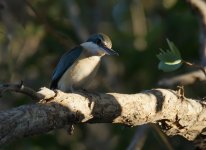 Sacred Kingfisher_Parry Farm_060813a.jpg197.3 KB · Views: 31
Sacred Kingfisher_Parry Farm_060813a.jpg197.3 KB · Views: 31 -
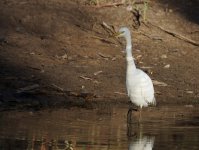 Intermediate Egret_Parry Farm_060813a.jpg300.1 KB · Views: 25
Intermediate Egret_Parry Farm_060813a.jpg300.1 KB · Views: 25 -
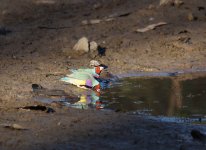 Gouldian Finch_Parry Farm_060813a.jpg284.6 KB · Views: 60
Gouldian Finch_Parry Farm_060813a.jpg284.6 KB · Views: 60 -
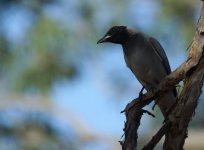 BF Cuckooshrike_Parry Farm_060813a.jpg144 KB · Views: 33
BF Cuckooshrike_Parry Farm_060813a.jpg144 KB · Views: 33 -
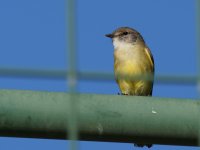 Lemon Bellied Flycatcher_Parry Farm_060813a.jpg122 KB · Views: 30
Lemon Bellied Flycatcher_Parry Farm_060813a.jpg122 KB · Views: 30




